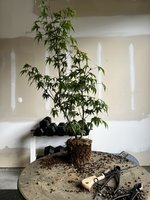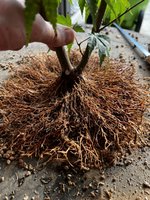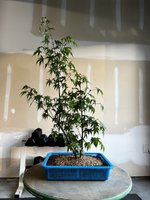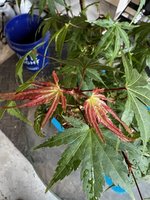D
Deleted member 32750
Guest
Last year I purchased 2 ’Nishiki Gawa’ rough bark maples from Mr. Maple. Obviously these were grafted trees meant for landscape, but I love the rough bark varieties of maple bonsai, so I had to try to airlayer one to start it on the path as a bonsai.
I started the airlayer sometime in May I believe, after the first flush of growth hardened off.
I checked the roots today and was surprised at how many roots the tree produced, so I decided to go ahead and remove the layer.
Here is a picture of the roots that were produced in approximately 1.5-2 months.

Here is a photo after teasing away the soil and sphagnum moss.

This is the best result I have had with an airlayer so far. This tree now has a nearly 360 degree nebari that will eventually develop rough bark. There is one spot on the backside that may eventually need a root graft, but hopefully new roots will sprout from that area.
I think its safe to say this cultivar air layers quite easily.
I repotted the tree into a shallow collander for now and put a small board under the tree to encourage lateral root spread. The tree was potted in Aoki blend bonsai soil (80% akadama, 15% Kiryu, 5% lava) and shredded sphagnum/green moss was placed on top of the soil over the root system to ensure moisture retention in the root zone

This tree will be fertilized generously and allowed to grow freely for the remainder of the growing season.
In winter I will begin to cut back drastically so I can build primary lines with taper/movement starting next growing season. This will be a long term project for me, but I look forward to documenting the progress for a long term deciduous project here.
Stay tuned!
bonus photo: incredible color on the new growth!

I started the airlayer sometime in May I believe, after the first flush of growth hardened off.
I checked the roots today and was surprised at how many roots the tree produced, so I decided to go ahead and remove the layer.
Here is a picture of the roots that were produced in approximately 1.5-2 months.

Here is a photo after teasing away the soil and sphagnum moss.

This is the best result I have had with an airlayer so far. This tree now has a nearly 360 degree nebari that will eventually develop rough bark. There is one spot on the backside that may eventually need a root graft, but hopefully new roots will sprout from that area.
I think its safe to say this cultivar air layers quite easily.
I repotted the tree into a shallow collander for now and put a small board under the tree to encourage lateral root spread. The tree was potted in Aoki blend bonsai soil (80% akadama, 15% Kiryu, 5% lava) and shredded sphagnum/green moss was placed on top of the soil over the root system to ensure moisture retention in the root zone

This tree will be fertilized generously and allowed to grow freely for the remainder of the growing season.
In winter I will begin to cut back drastically so I can build primary lines with taper/movement starting next growing season. This will be a long term project for me, but I look forward to documenting the progress for a long term deciduous project here.
Stay tuned!
bonus photo: incredible color on the new growth!



